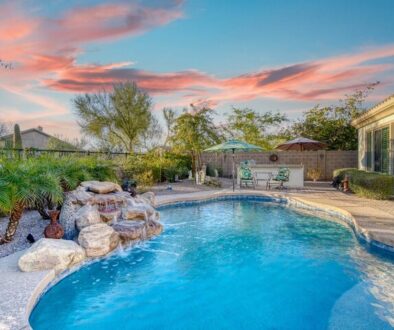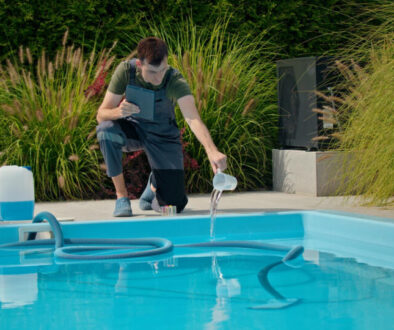 Ah, the dreaded green pool. It’s the bane of every pool owner’s existence. One minute you’re envisioning refreshing dips in crystal-clear water, the next you’re staring at a swamp-like scene, wondering where it all went wrong. Fear not, fellow pool enthusiasts! This guide will equip you with the knowledge and strategies to ban the green and keep your pool sparkling blue all season long.
Ah, the dreaded green pool. It’s the bane of every pool owner’s existence. One minute you’re envisioning refreshing dips in crystal-clear water, the next you’re staring at a swamp-like scene, wondering where it all went wrong. Fear not, fellow pool enthusiasts! This guide will equip you with the knowledge and strategies to ban the green and keep your pool sparkling blue all season long.
Understanding the Culprit: Why Pools Turn Green
The primary cause of a green pool is algae. These microscopic plants thrive in warm, sunny environments (sound familiar, Florida residents?), especially when the water chemistry is unbalanced. Think of it like this: you’re creating the perfect breeding ground for these unwanted guests. Here’s a breakdown of the common culprits:
- Improper Sanitizer Levels: Chlorine or salt chlorine generators are your pool’s first line of defense against algae. When these levels are too low, algae can quickly take over.
- pH Imbalance: An incorrect pH level can make your sanitizer less effective, even if the levels seem adequate. Think of it like trying to fight a fire with a leaky hose.
- Poor Circulation: Proper water circulation is essential for distributing sanitizer and preventing stagnant areas where algae can flourish. A faulty pump or filter can contribute to this problem.
- Inadequate Filtration: Your filter removes debris and helps keep the water clear. A dirty or malfunctioning filter can allow algae to thrive.
- Lack of Regular Cleaning: Regular skimming, brushing, and vacuuming are essential for removing organic matter that algae feed on.
- Environmental Factors: Rain, leaves, pollen, and even excessive sunlight can contribute to algae growth.
Your Arsenal Against the Green: Prevention is Key
The best way to deal with a green pool is to prevent it in the first place. Here’s your preventative maintenance checklist:
-
Regular Testing and Balancing: Test your pool water chemistry at least once a week, ideally twice during peak swimming season. Maintain the following ranges:
- pH: 7.4 – 7.6
- Total Alkalinity: 80 – 120 ppm
- Calcium Hardness: 200 – 400 ppm
- Chlorine: 1 – 3 ppm (or follow your salt chlorine generator’s recommendations)
-
Consistent Sanitization: Ensure your chlorine or salt chlorine generator is functioning correctly and maintaining adequate sanitizer levels. Shock your pool regularly (usually weekly) to eliminate any lingering bacteria or organic matter.
-
Proper Circulation: Run your pool pump for an adequate amount of time each day (typically 8-12 hours) to ensure proper water circulation.
-
Filter Maintenance: Clean your filter regularly according to the manufacturer’s instructions. Backwash your filter as needed and replace the filter media when recommended.
-
Regular Cleaning: Skim your pool regularly to remove debris. Brush the walls and floor at least once a week to prevent algae from clinging to surfaces. Vacuum your pool as needed to remove settled debris.
-
Algaecide (Use with Caution): While not always necessary, a preventative dose of algaecide can provide an extra layer of protection, especially during hot weather. Choose an algaecide that is compatible with your pool type and follow the instructions carefully.
-
Address Environmental Factors: Trim overhanging trees to reduce leaf and debris fall. Consider using a pool cover to protect your pool from the elements.
Dealing with a Green Pool: Rescue Mission
If your pool has already turned green, don’t panic! Here’s your rescue mission:
-
Test and Balance: Test your water chemistry and adjust the pH and alkalinity to the correct ranges.
-
Shock Treatment: Super-chlorinate your pool using a high dose of shock. Follow the instructions on the shock product carefully.
-
Brush and Vacuum: Brush the walls and floor thoroughly to dislodge the algae. Vacuum the pool to remove the dead algae.
-
Filter Cleaning: Clean your filter thoroughly to remove any remaining algae.
-
Clarifier (Optional): A clarifier can help to clump together any remaining algae particles, making them easier to filter out.
-
Test and Rebalance: After the shock treatment, test your water chemistry again and rebalance as needed.
Prevention is Always Better Than Cure
Keeping your pool sparkling blue requires consistent effort, but it’s far easier than dealing with a green pool. By following these tips, you can enjoy a healthy and inviting pool all season long. So, ditch the green and embrace the blue!



